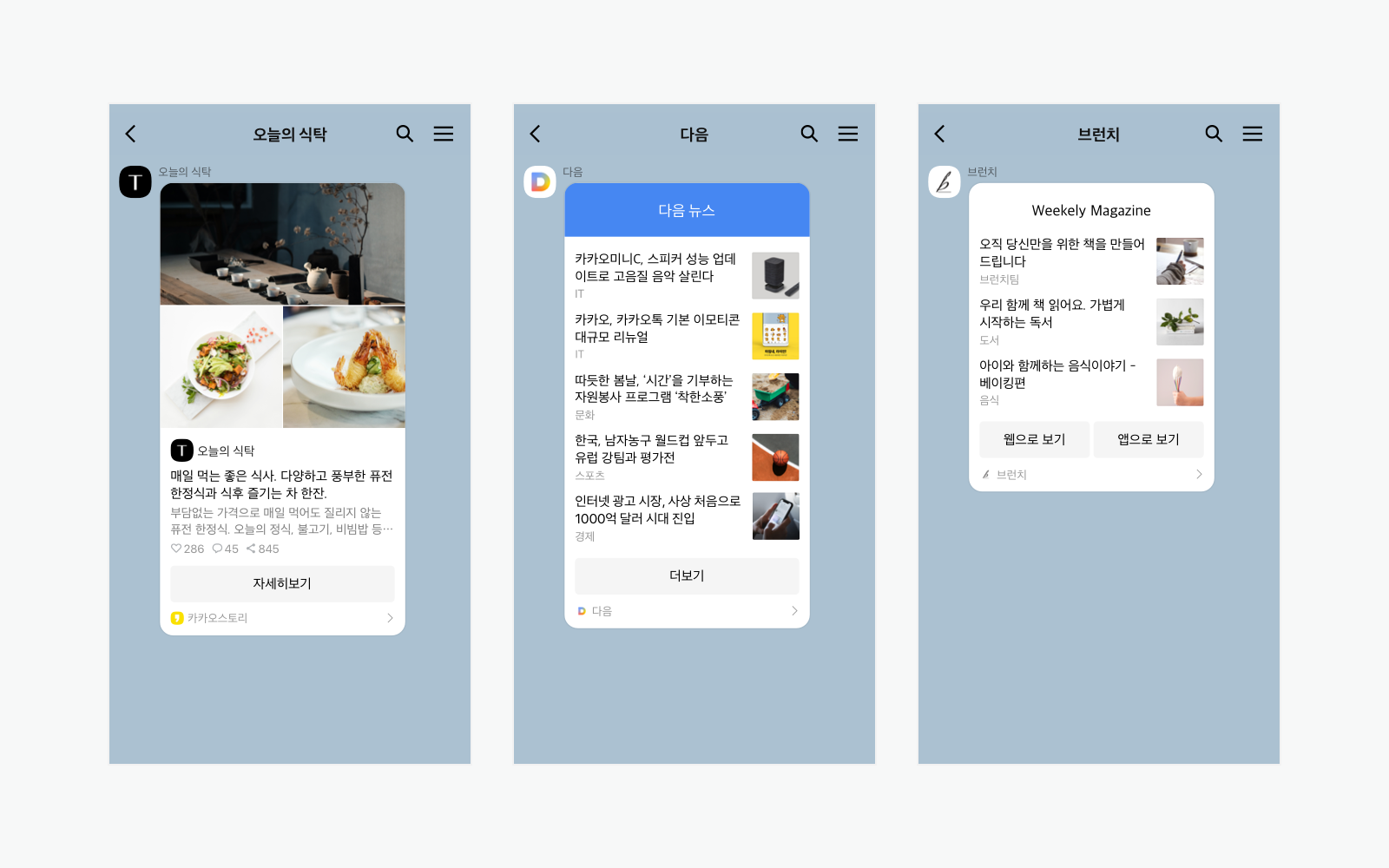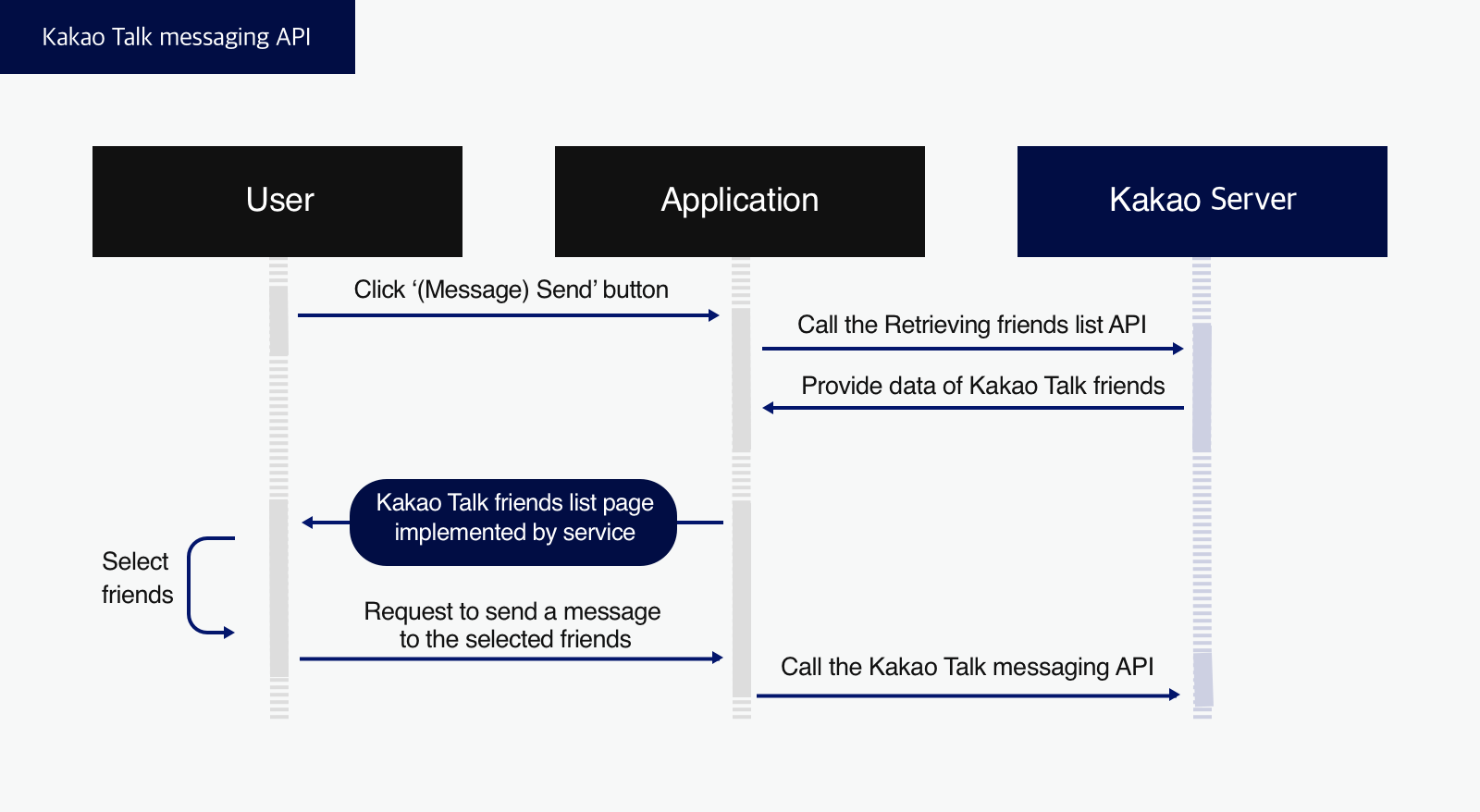- Docs>
- Kakao Talk Message>
- Concepts
menu
Getting started
Kakao Developers
Login
Communication
Advertisement
- Concepts
- Ad creation: Ad account
- Ad creation: Campaign
- Ad creation: Ad group
- Targeting for ad group
- Custom audience targeting for ad group
- Ad creation: Creative common
- Ad creation: Display creative
- Ad creation: Message creative
- Ad creation: Personalized message creative
- Bizboard landing settings
- Report
- Message management
- Personalized message management
- Message ad management
- Message ad operation
- Ad View management
- Business Form linkage management
- Pixel & SDK linkage management
- Audience management
- Engagement targeting management
- Customer file management
- Friend group management
- Ad account management
- Reference
- Type information
- Error code
Kakao Talk Message


Concepts
This document introduces the Kakao Talk Message API.
The Kakao Talk Message API only supports sending messages between users within the same service, and the Kakao Talk Social API permission is required to provide the message sending feature to friends. For more details, see Message sending features and How to use.
Overview
Message sending features
This section introduces various Kakao Talk message sending features provided by Kakao. The differences between products can be found in the table below.
| Product | Description | Service → User message sending |
Available platform |
|---|---|---|---|
| Kakao Talk Share | Users select content in the service and share it to Kakao Talk chatrooms themselves. Recommended use: Implementing content sharing features between users. |
Not supported. | Kakao Developers |
| Kakao Talk Message | Users send messages to their Kakao Talk friends who use the same service, for interaction purposes. Recommended use: Implementing message sending for user interactions. |
Not supported. | Kakao Developers |
| Brand Message | The service sends promotional or informational messages to marketing consented members. Recommended use: Sending promotional or informational messages to users. |
Conditionally supported. (Limited to members who have consented to receive marketing.) |
Kakao Business |
| Info Talk | The service sends informational messages to users. Recommended use: Sending informational messages to users. |
Supported. | Kakao Business |
| CS Talk | Users can open a Kakao Talk chatroom to make inquiries about the service. Recommended use: Implementing customer support using real-time chat or chatbot. |
Conditionally supported. (After a user initiates a consultation) |
Kakao Business |
Select the product that fits your service needs based on the guide below.
- If your service requires sending messages between users, choose the appropriate product between Kakao Talk Share and Kakao Talk Message.
- If your service needs to send messages directly to users, choose the appropriate product between Brand Message and Info Talk.
- If your service requires a customer support feature, select the CS Talk product.
For details on Brand Message, Info Talk, and CS Talk, see the Kakao Business document.
Differences between Kakao Talk Share and Kakao Talk Message features
This section explains the differences between Kakao Talk Share and Kakao Talk Message, both of which are Kakao Talk Message sending features provided by Kakao Developers. Both features only support user-to-user messaging, and services cannot send messages directly to users.
Refer to the table below to check the feature differences and choose the product that best suits your service requirements.
| Item | Kakao Talk Share | Kakao Talk Message |
|---|---|---|
| Message recipients | All Kakao Talk friends of the user | Friends who meet the information provision conditions of the Retrieve friends list API. |
| Recipient selection UI | No separate implementation required. | Requires calling the Friend picker API or implementing a UI using the Retrieve friends list API. |
| Message sending method | When the user selects recipients in the Kakao Talk app, the sharing message is automatically sent. | After providing a recipient selection UI, the Kakao Talk Message API must be called with the selected recipients. |
| Permission required | X | O |
| REST API supported | X | O |
| Confirmation of message delivery success | Confirm via the Kakao Talk Share webhook. | Confirm via API response. |
Kakao Talk Message
Kakao Talk Message is a feature that allows users to send messages to their Kakao Talk friends who use the same service for the purpose of interaction. This feature provides an environment where users can interact by sending messages to each other, or enables personalized services by allowing users to send messages to themselves.
For the types and characteristics of various message sending features provided by Kakao, see Message sending features. For the differences between the message sending features provided by Kakao Developers, see Differences between Kakao Talk Share and Kakao Talk Message features.

Kakao Talk Message process
This section explains how a user sends a Kakao Talk Message from a service. Refer to the sequence diagram and step-by-step explanation below.

- When a user selects the Kakao Talk Message send button on the service screen, the service provides a UI to select recipients through one of the following methods.
- Call the Friends picker API.
- Provide a UI for selecting recipients from the response of the Retrieve user list API.
- When the user selects the desired recipients using the Friend picker or service UI, the service receives the recipient information as a response.
- The service sends a Kakao Talk message by calling the Kakao Talk Message API with the recipient information and message parameters composed with a message template.
How to use
The Kakao Talk Message API allows app users to send messages directly to their Kakao Talk friends or themselves. If you want to send informational messages such as order or delivery notifications, you must use AlimTalk(알림톡). AlimTalk is separately reviewed and operated on Kakao Business. If you apply for the Message API to use AlimTalk, your application will be rejected during the review. Please check the required features before applying.
To apply the feature of sending messages to friends using the Kakao Talk Message API in your service, you must request additional features and obtain permission. Apps without permission and their test apps can only send messages to the app's team members.
You can apply for permission by following the steps below.
- In the App Management page, go to [Kakao Login] > [Consent Items] and set the following two consent items:
- [Personal Information] > [Friends list in Kakao service (including profile photo, nickname, favorites)]
- [Access Permission] > [Send Kakao Talk Message]
- Implement the message sending feature. (See: Provided APIs)
- Test the feature to ensure it works properly for app members.
- Prepare the required materials by referring to Additional feature application information.
- Note: You need permission to retrieve and send messages to users other than app members, and you must apply for additional features to obtain this permission.
- In [App] > [Request Additional Features] > [Kakao Talk Friends/Message], select [Apply] to request the additional feature. To apply, you must complete the following tasks. (See: Request Additional Features)
- Enter the Additional feature application information and click the [Apply] button to request a review. The review result will be sent to the emails of the app members.
Additional feature application information
- Service information: Enter the service web page or application download URL.
- Service application screen: Upload a screenshot of the actual screen where the message sending feature is applied.
- Only one file in JPG, JPEG, PNG, or PDF format under 20 MB can be uploaded.
- Reason for application and usage scenario: Describe in detail the purpose for which this feature is needed in your service, and the scenario in which a user logs in to the service and sends a message to their Kakao Talk friends.
You must mask all personal information in screenshots and application forms before submitting. If personal information is included in the application, the request is rejected for the purpose of personal information destruction.
Usage policy
Quota
Kakao API applies monthly and daily quotas for stable service. You can check the currently applied quota information in the Quota.
The Kakao Talk Message API has a limited quota before you get the permission via requesting permission, and the quota limit cannot be increased to protect users from frequent messages.
Preference to receive messages
Ensure that a Kakao Talk message sent through the Kakao Talk Message API can be delivered only to the users who allow showing their profile on the Friends list of a service.
Users can change the profile visibility option by selecting [Preferences] at the bottom right of the message sent from the user's friends or on [Manage connected services] page. To see more details, refer to Profile visibility settings.
If a user wants to block messages from a service, the user needs to disable the 'Show my profile on Friends list' option. Then, the user is not included in the response of the Retrieving list of friends API, and the user's friends cannot send any messages from the service because the user is not displayed on the Friends list.
Firewall and ACL
If access to the service server is restricted Kakao's server by the firewall or ACL (Access Control List), Kakao Talk Share message may not display the image or works slowly.
In this case, you must set the firewall rules or ACL to scrape your web page for Kakao Talk Share. Refer to Retrieve Kakao IP list.
Provided APIs
- Refer to Scope of support to know whether each Kakao SDK supports each feature.
| API | Description | Documentation |
|---|---|---|
| Send me message with default template | Sends a message with a default template to myself through Kakao Talk. | REST API JavaScript Android iOS Flutter |
| Send me message with custom template | Sends a message with a custom template to myself through Kakao Talk. | REST API JavaScript Android iOS Flutter |
| Send me scrape message | Scrapes a specific web page and sends a message to myself through Kakao Talk. | REST API JavaScript Android iOS Flutter |
| Send friends message with default template | Sends a message with a default template to a friend through Kakao Talk. | REST API JavaScript Android iOS Flutter |
| Send friends message with custom template | Sends a message with a custom template to a friend through Kakao Talk. | REST API JavaScript Android iOS Flutter |
| Send friends scrape message | Scrapes a specific web page and sends a message to a friend through Kakao Talk. | REST API JavaScript Android iOS Flutter |
| Upload image | Uploads an image for use in messages. | JavaScript Android iOS Flutter |